If you’ve ever wondered about the calorie content of a 4 oz steak, you’ve come to the right place.
A 4 oz portion of boneless, cooked beef steak contains 286 calories, 17.02g of fat, 0g of carbs, and 30.95g of protein. It is important to note that the calorie breakdown is 55% fat, 0% carbs, and 45% protein. This portion size is commonly consumed and provides nutrients such as vitamin D, calcium, iron, and potassium.
Key Takeaways:
- A 4 oz steak contains approximately 286 calories.
- This portion size is high in protein and low in carbs.
- It provides essential nutrients like vitamin D, calcium, iron, and potassium.
- The majority of the calories come from fat, with approximately 55% of the total calorie content.
- Individual dietary needs may vary, and it is always recommended to consult a healthcare professional for personalized advice.
How Many Calories in a 4 oz Steak?
Let’s dive into the numbers and uncover the precise calorie count of a 4 oz serving of steak. A 4 oz portion of boneless, cooked beef steak contains 286 calories. This information allows you to make informed choices about your dietary intake and plan meals accordingly.
When it comes to the breakdown of calories in a 4 oz steak, it’s important to note that the distribution is 55% fat and 45% protein. While fat is a necessary component of a balanced diet, it’s important to be mindful of portion sizes to maintain overall health.
| Calories | Fat | Carbs | Protein |
|---|---|---|---|
| 286 | 17.02g | 0g | 30.95g |
By incorporating a variety of foods into your diet, you can ensure that you’re getting the essential nutrients your body needs. A 4 oz steak portion provides valuable nutrients such as vitamin D, calcium, iron, and potassium. These nutrients are important for maintaining overall health and well-being.
As always, it’s crucial to consider individual dietary needs and consult with a healthcare professional if necessary. Let’s make conscious choices about our food intake and enjoy the deliciousness of steak while nourishing our bodies.
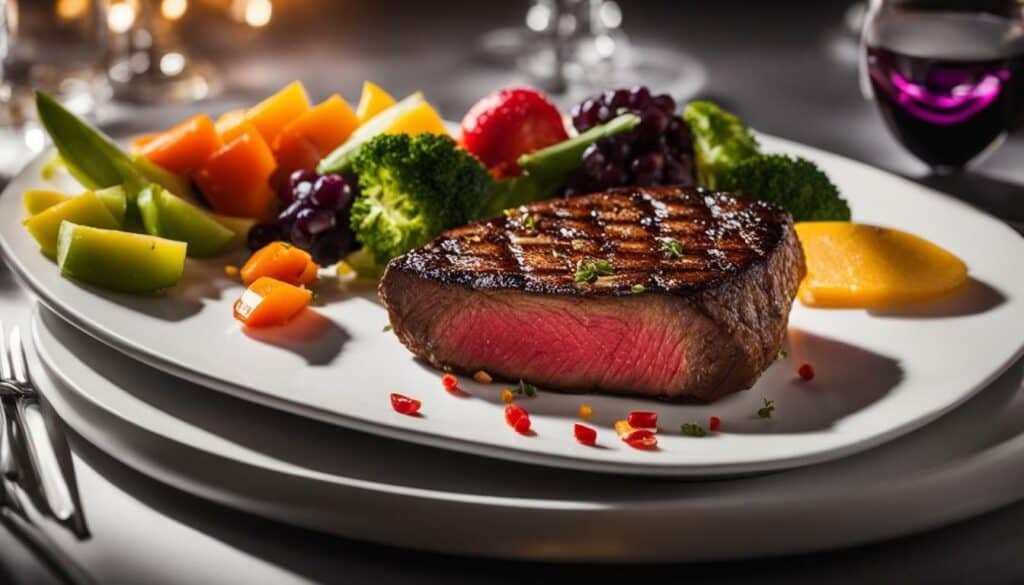
Understanding the nutritional value of a 4 oz steak goes beyond just calorie count – let’s delve into the vital nutrients it provides. A 4 oz portion of boneless, cooked beef steak contains 286 calories, 17.02g of fat, 0g of carbs, and 30.95g of protein. It is important to note that the calorie breakdown is 55% fat, 0% carbs, and 45% protein. This portion size is commonly consumed and provides nutrients such as vitamin D, calcium, iron, and potassium.
| Calories | Fat | Carbs | Protein |
|---|---|---|---|
| 286 | 17.02g | 0g | 30.95g |
Ribeye steak, another popular cut of beef, provides 199 calories, 10.8g of fat, 0g of carbs, and 23.8g of protein in a 3 oz serving. It is a good source of iron, zinc, niacin, vitamin B6, and vitamin B12. Ribeye steak is also associated with maintaining muscle mass, promoting weight loss, and preventing anemia.
| Calories | Fat | Carbs | Protein |
|---|---|---|---|
| 199 | 10.8g | 0g | 23.8g |
The American Heart Association recommends limiting saturated fat intake to about 13 grams per day, so it is important to be mindful of the amount of fat consumed in ribeye steak. The quality of beef can be graded as Prime, Choice, or Select, with Prime having the highest marbling and Choice being a high-quality option. Grass-fed beef is also an option for those who prefer it.
Incorporating moderate portions of beef, such as ribeye steak, into a healthy eating pattern can provide essential nutrients and promote overall health. However, it is important to consider individual dietary needs and consult a healthcare professional if necessary.
The Importance of Portion Size
Portion sizes play a significant role in maintaining a healthy balance, so let’s talk about why it’s important when it comes to steak. When enjoying a delicious steak, it’s important to be mindful of how much we consume to ensure we are meeting our nutritional needs without overindulging. By paying attention to portion sizes, we can enjoy the taste and benefits of steak while keeping our calorie intake in check.
To better understand the impact of portion size, let’s take a closer look at the nutritional value of a 4 oz serving of steak. A 4 oz portion of boneless, cooked beef steak contains 286 calories, consisting of 55% fat, 0% carbs, and 45% protein. While steak can be a rich source of protein and essential nutrients, consuming larger portions may lead to excessive calorie intake, which can contribute to weight gain and potential health issues.
By being mindful of portion sizes, you can still enjoy the taste and benefits of steak while maintaining a balanced diet. For instance, opting for a 4 oz serving allows you to enjoy the flavors and nutrients of the steak without going overboard on calorie intake. It’s also important to consider the quality of the beef, as different cuts offer varying levels of marbling and fat content. Choosing leaner cuts and trimming visible fat can help reduce overall calorie and fat intake.
Remember, portion control is about finding the right balance that works for you and your nutritional needs. If you have specific dietary requirements or health concerns, it’s always best to consult a healthcare professional who can provide personalized guidance. By being mindful of portion sizes and making informed choices, you can enjoy the deliciousness of steak while maintaining a healthy eating pattern.
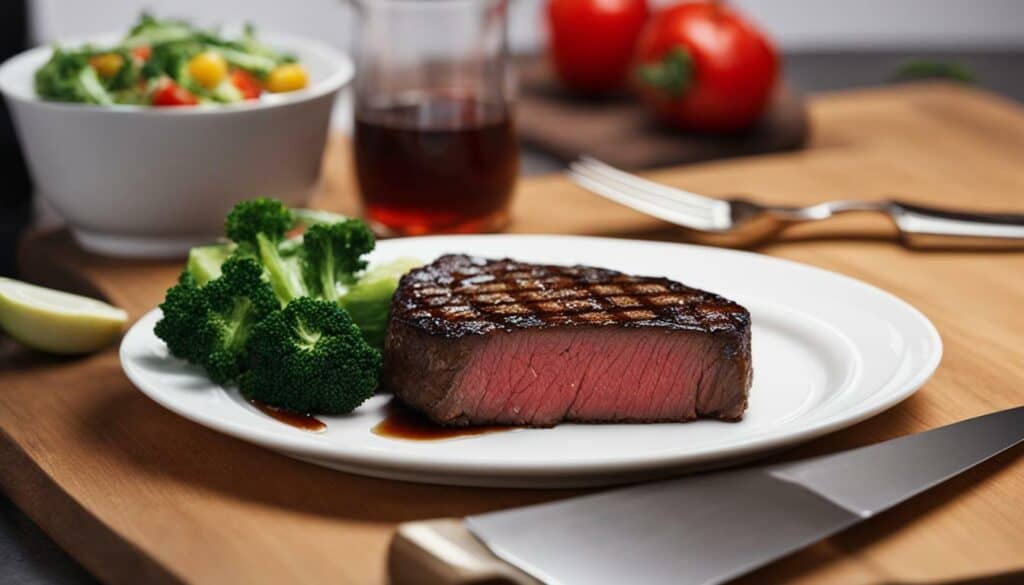
| Nutrient | 4 oz Steak |
|---|---|
| Calories | 286 |
| Fat | 17.02g |
| Carbs | 0g |
| Protein | 30.95g |
Exploring Ribeye Steak Calories
If you’re a fan of ribeye steak, let’s take a closer look at the specific calorie count of a 4 oz serving. A 4 oz portion of boneless, cooked ribeye steak contains approximately 286 calories. This flavorful cut of beef is known for its marbling, which contributes to its rich taste and tenderness. However, it’s important to enjoy ribeye steak in moderation, as it can be higher in calories and fat compared to leaner cuts.
Along with its calorie content, a 4 oz serving of ribeye steak provides about 17.02g of fat and 30.95g of protein. The fat content consists of approximately 55% of the overall calories, while protein makes up around 45%. It’s worth noting that ribeye steak contains zero carbohydrates, making it a suitable choice for those following low-carb or ketogenic diets.
Ribeye steak also offers various essential nutrients. In a 3 oz serving, it provides approximately 10.8g of fat, 23.8g of protein, and 199 calories. This cut of beef is a good source of iron, zinc, niacin, vitamin B6, and vitamin B12. These nutrients play important roles in energy production, immune function, and overall health.
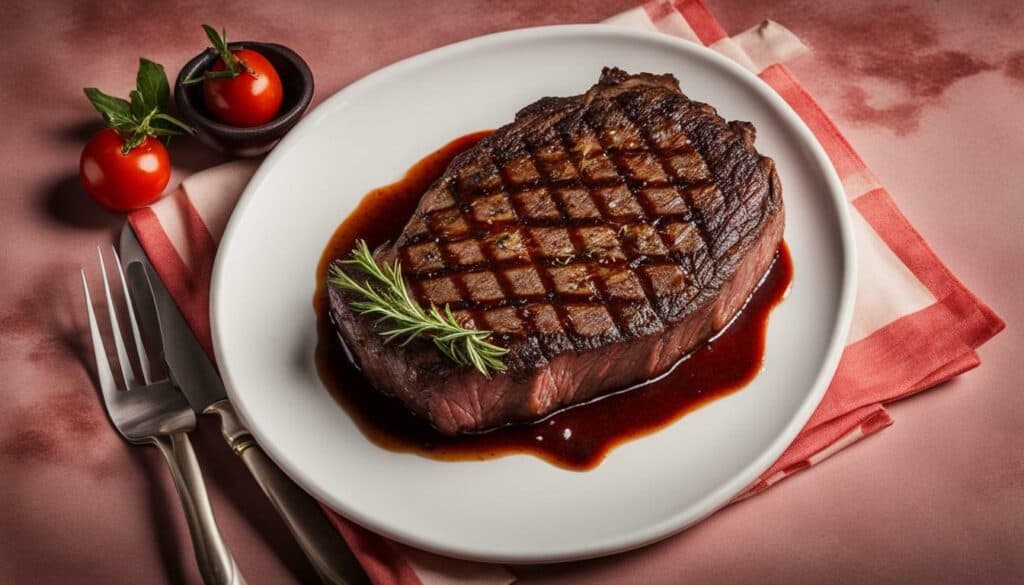
When selecting ribeye steak, it’s essential to consider the quality of the beef. Beef can be graded as Prime, Choice, or Select, with Prime having the highest marbling and tenderness. Choice is also a high-quality option, while Select is leaner but may be less tender. Additionally, opting for grass-fed beef can be a preference for those looking for more sustainable and naturally raised meat.
Incorporating moderate portions of ribeye steak into a healthy eating pattern can provide essential nutrients and contribute to overall well-being. However, it’s crucial to be mindful of portion sizes and consider individual dietary needs. If you have specific health concerns or dietary restrictions, it’s advisable to consult a healthcare professional or registered dietitian for personalized guidance.
Nutrients in Ribeye Steak
Ribeye steak not only satisfies your taste buds but also provides a range of important nutrients – let’s explore them. A 4 oz portion of ribeye steak contains approximately 199 calories, 10.8g of fat, 0g of carbs, and 23.8g of protein. This flavorful cut of beef is not only delicious but also offers various essential vitamins and minerals.
In terms of vitamins, ribeye steak is a good source of vitamin B6 and vitamin B12. Vitamin B6 plays a crucial role in brain development and function, while vitamin B12 is essential for the production of red blood cells and DNA synthesis. Ribeye steak also provides important minerals like iron, zinc, and niacin. Iron is necessary for oxygen transportation in the blood and helps prevent iron-deficiency anemia. Zinc is important for immune function and wound healing, while niacin is essential for energy production and supports a healthy nervous system.
To make an informed choice when selecting ribeye steak, it’s worth considering the quality of the beef. The quality can be graded as Prime, Choice, or Select, with Prime having the highest marbling and Choice being a high-quality option. Additionally, some individuals may prefer grass-fed beef, which offers its own unique flavor and nutritional profile.
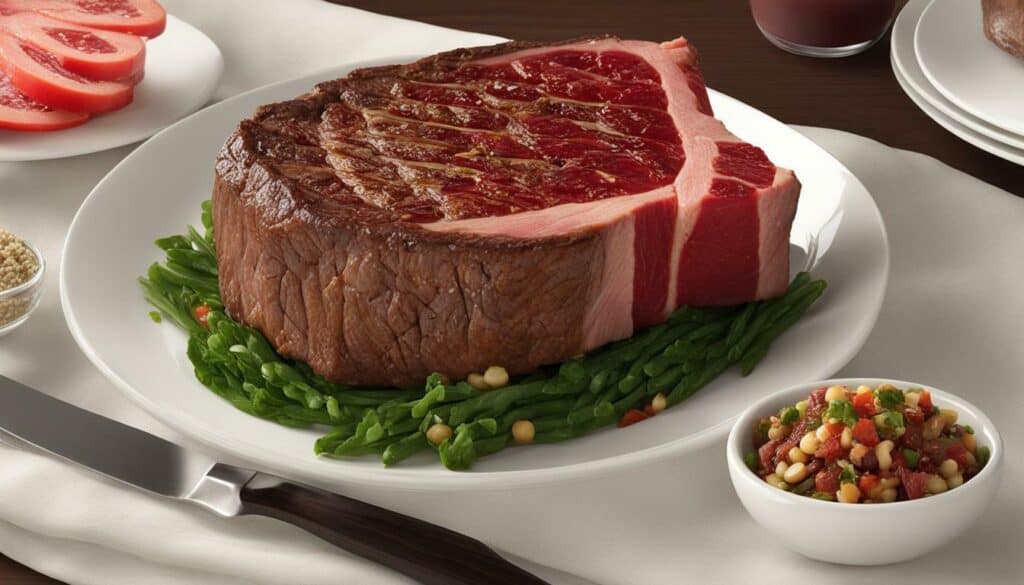
When incorporating ribeye steak into a healthy eating pattern, it’s important to be mindful of portion sizes. Although ribeye steak provides valuable nutrients, it also contains saturated fat. The American Heart Association recommends limiting saturated fat intake to about 13 grams per day. Consulting a healthcare professional can help determine the right amount of ribeye steak to include in your diet based on individual dietary needs.
| Nutrient | Amount per 4 oz portion |
|---|---|
| Calories | 199 |
| Fat | 10.8g |
| Carbs | 0g |
| Protein | 23.8g |
| Vitamin B6 | 0.5mg |
| Vitamin B12 | 1.2mcg |
| Iron | 2.8mg |
| Zinc | 3.5mg |
| Niacin | 4.1mg |
Choosing Quality and Quantity
Making informed choices about the quality and quantity of steak we consume can help us maintain a healthy lifestyle. When it comes to quality, choosing the right grade of beef and considering factors such as marbling can make a significant difference in taste and nutritional content. The three main grades of beef are Prime, Choice, and Select. Prime beef has the highest degree of marbling, making it incredibly tender and flavorful. Choice beef is also a great option, offering a good balance of marbling and quality. Select beef is leaner but can still be enjoyed when prepared properly.
Aside from grade, another aspect to consider is whether the beef is grass-fed or grain-fed. Grass-fed beef comes from cattle that have been raised on a natural grass diet, which can result in a leaner meat that is higher in certain nutrients such as omega-3 fatty acids. Grain-fed beef, on the other hand, has a richer flavor and tends to be more marbled.
When it comes to quantity, portion control is key. While steak can be a delicious and nutritious part of a balanced diet, it’s important to be mindful of serving sizes. A 4 oz portion of steak is a reasonable serving that provides a good amount of protein and other essential nutrients. It’s also worth noting that cooking methods can impact the overall calorie and fat content of the steak, so opting for healthier cooking techniques like grilling or broiling can help keep the dish nutritious.
| Steak Cut | Calories (per 4 oz) | Protein (g) | Fat (g) | Carbs (g) |
|---|---|---|---|---|
| Beef Steak (Boneless, Cooked) | 286 | 30.95 | 17.02 | 0 |
| Ribeye Steak (Cooked) | 199 | 23.8 | 10.8 | 0 |
By being mindful of the quality and quantity of steak we consume, we can enjoy this flavorful protein source while also prioritizing our health. Whether you prefer a juicy ribeye or a tender sirloin, moderation and wise choices can go a long way in maintaining a well-rounded and balanced diet.

Discover how you can enjoy steak as part of a healthy diet while still meeting your nutritional needs. Many people believe that steak should be avoided when striving for a balanced eating plan, but when consumed in moderation and with mindfulness, steak can be a nutritious addition to your meals.
First, let’s take a closer look at the nutritional value of a 4 oz portion of steak. This size of beef steak typically contains around 286 calories, with a breakdown of 55% fat and 45% protein. It is important to note that steak is also a great source of essential nutrients such as vitamin D, calcium, iron, and potassium. These nutrients play crucial roles in maintaining bone health, supporting muscle function, and promoting overall well-being.
When choosing steak, it’s important to consider the quality and quantity. Opting for high-quality cuts, such as Prime or Choice beef, ensures that you are getting the best flavor and tenderness. Additionally, being mindful of portion sizes is key. A 4 oz portion is a moderate serving that can provide the nutrients your body needs without going overboard on calories or fat.
| Steak Cut | Calories per 4 oz | Fat per 4 oz | Protein per 4 oz |
|---|---|---|---|
| Ribeye | 286 | 17.02g | 30.95g |
| Sirloin | 217 | 11.27g | 29.92g |
| T-Bone | 271 | 19.83g | 24.74g |
By incorporating steak into your healthy eating pattern, you can enjoy its rich flavor and reap the nutritional benefits it offers. It’s important to note that individual dietary needs may vary, so consulting a healthcare professional or registered dietitian is always recommended. They can provide personalized guidance and help you create a balanced meal plan that suits your needs and preferences.
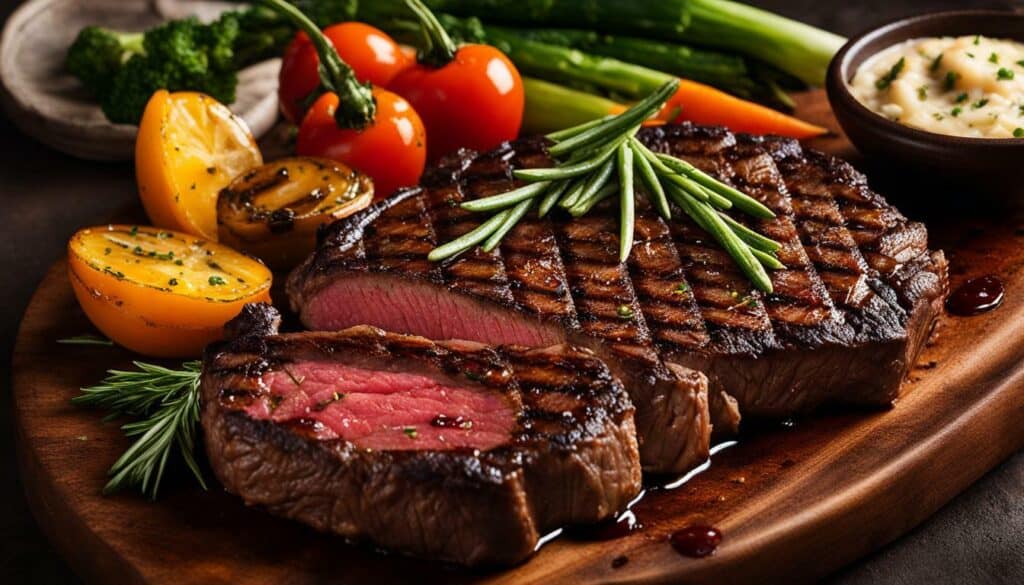
Remember, balance is key when it comes to a healthy diet. Enjoy steak as part of a well-rounded meal that includes a variety of fruits, vegetables, whole grains, and lean proteins. By making mindful choices and being aware of portion sizes, you can savor the deliciousness of steak while supporting your overall health and well-being.
Conclusion
By understanding the calorie and nutrient content of steak, we can make informed choices that align with our health goals.
A 4 oz portion of boneless, cooked beef steak contains 286 calories, 17.02g of fat, 0g of carbs, and 30.95g of protein. It is important to note that the calorie breakdown is 55% fat, 0% carbs, and 45% protein. This portion size is commonly consumed and provides nutrients such as vitamin D, calcium, iron, and potassium.
Ribeye steak, another popular cut of beef, provides 199 calories, 10.8g of fat, 0g of carbs, and 23.8g of protein in a 3 oz serving. It is a good source of iron, zinc, niacin, vitamin B6, and vitamin B12. Ribeye steak is also associated with maintaining muscle mass, promoting weight loss, and preventing anemia.
The American Heart Association recommends limiting saturated fat intake to about 13 grams per day, so it is important to be mindful of the amount of fat consumed in ribeye steak. The quality of beef can be graded as Prime, Choice, or Select, with Prime having the highest marbling and Choice being a high-quality option. Grass-fed beef is also an option for those who prefer it.
Incorporating moderate portions of beef, such as ribeye steak, into a healthy eating pattern can provide essential nutrients and promote overall health. However, it is important to consider individual dietary needs and consult a healthcare professional if necessary.
FAQ
Q: How many calories are in a 4 oz steak?
A: A 4 oz portion of boneless, cooked beef steak contains 286 calories.
Q: What is the nutritional value of a 4 oz steak?
A: A 4 oz steak has 17.02g of fat, 0g of carbs, and 30.95g of protein. The calorie breakdown is 55% fat, 0% carbs, and 45% protein.
Q: How many calories are in a 3 oz ribeye steak?
A: A 3 oz serving of ribeye steak provides 199 calories.
Q: What are the nutrients in ribeye steak?
A: Ribeye steak is a good source of iron, zinc, niacin, vitamin B6, and vitamin B12.
Q: How much saturated fat should I limit when consuming ribeye steak?
A: The American Heart Association recommends limiting saturated fat intake to about 13 grams per day. It’s important to be mindful of the amount of fat consumed in ribeye steak.
Q: What is the difference between Prime, Choice, and Select beef?
A: The quality of beef can be graded as Prime, Choice, or Select. Prime beef has the highest marbling, while Choice is a high-quality option. Grass-fed beef is also available for those who prefer it.
Q: Can I incorporate steak into a healthy eating pattern?
A: Yes, moderate portions of beef, such as ribeye steak, can provide essential nutrients and promote overall health. It’s important to consider individual dietary needs and consult a healthcare professional if necessary.
Can Queso Be Part of a Healthy Eating Plan?
Can queso be part of a healthy eating plan? It’s essential to consult a queso calorie guide for healthy eating. While queso is delicious and versatile, it is often high in calories and saturated fat. However, by practicing moderation and portion control, enjoying queso as an occasional treat can still fit into a balanced diet.
Key Takeaways:
- A 4 oz steak contains approximately 286 calories.
- This portion size is high in protein and low in carbs.
- It provides essential nutrients like vitamin D, calcium, iron, and potassium.
- The majority of the calories come from fat, with approximately 55% of the total calorie content.
- Individual dietary needs may vary, and it is always recommended to consult a healthcare professional for personalized advice.
How Many Calories in a 4 oz Steak?
Let’s dive into the numbers and uncover the precise calorie count of a 4 oz serving of steak. A 4 oz portion of boneless, cooked beef steak contains 286 calories. This information allows you to make informed choices about your dietary intake and plan meals accordingly.
When it comes to the breakdown of calories in a 4 oz steak, it’s important to note that the distribution is 55% fat and 45% protein. While fat is a necessary component of a balanced diet, it’s important to be mindful of portion sizes to maintain overall health.
| Calories | Fat | Carbs | Protein |
|---|---|---|---|
| 286 | 17.02g | 0g | 30.95g |
By incorporating a variety of foods into your diet, you can ensure that you’re getting the essential nutrients your body needs. A 4 oz steak portion provides valuable nutrients such as vitamin D, calcium, iron, and potassium. These nutrients are important for maintaining overall health and well-being.
As always, it’s crucial to consider individual dietary needs and consult with a healthcare professional if necessary. Let’s make conscious choices about our food intake and enjoy the deliciousness of steak while nourishing our bodies.

Understanding the nutritional value of a 4 oz steak goes beyond just calorie count – let’s delve into the vital nutrients it provides. A 4 oz portion of boneless, cooked beef steak contains 286 calories, 17.02g of fat, 0g of carbs, and 30.95g of protein. It is important to note that the calorie breakdown is 55% fat, 0% carbs, and 45% protein. This portion size is commonly consumed and provides nutrients such as vitamin D, calcium, iron, and potassium.
| Calories | Fat | Carbs | Protein |
|---|---|---|---|
| 286 | 17.02g | 0g | 30.95g |
Ribeye steak, another popular cut of beef, provides 199 calories, 10.8g of fat, 0g of carbs, and 23.8g of protein in a 3 oz serving. It is a good source of iron, zinc, niacin, vitamin B6, and vitamin B12. Ribeye steak is also associated with maintaining muscle mass, promoting weight loss, and preventing anemia.
| Calories | Fat | Carbs | Protein |
|---|---|---|---|
| 199 | 10.8g | 0g | 23.8g |
The American Heart Association recommends limiting saturated fat intake to about 13 grams per day, so it is important to be mindful of the amount of fat consumed in ribeye steak. The quality of beef can be graded as Prime, Choice, or Select, with Prime having the highest marbling and Choice being a high-quality option. Grass-fed beef is also an option for those who prefer it.
Incorporating moderate portions of beef, such as ribeye steak, into a healthy eating pattern can provide essential nutrients and promote overall health. However, it is important to consider individual dietary needs and consult a healthcare professional if necessary.
The Importance of Portion Size
Portion sizes play a significant role in maintaining a healthy balance, so let’s talk about why it’s important when it comes to steak. When enjoying a delicious steak, it’s important to be mindful of how much we consume to ensure we are meeting our nutritional needs without overindulging. By paying attention to portion sizes, we can enjoy the taste and benefits of steak while keeping our calorie intake in check.
To better understand the impact of portion size, let’s take a closer look at the nutritional value of a 4 oz serving of steak. A 4 oz portion of boneless, cooked beef steak contains 286 calories, consisting of 55% fat, 0% carbs, and 45% protein. While steak can be a rich source of protein and essential nutrients, consuming larger portions may lead to excessive calorie intake, which can contribute to weight gain and potential health issues.
By being mindful of portion sizes, you can still enjoy the taste and benefits of steak while maintaining a balanced diet. For instance, opting for a 4 oz serving allows you to enjoy the flavors and nutrients of the steak without going overboard on calorie intake. It’s also important to consider the quality of the beef, as different cuts offer varying levels of marbling and fat content. Choosing leaner cuts and trimming visible fat can help reduce overall calorie and fat intake.
Remember, portion control is about finding the right balance that works for you and your nutritional needs. If you have specific dietary requirements or health concerns, it’s always best to consult a healthcare professional who can provide personalized guidance. By being mindful of portion sizes and making informed choices, you can enjoy the deliciousness of steak while maintaining a healthy eating pattern.

| Nutrient | 4 oz Steak |
|---|---|
| Calories | 286 |
| Fat | 17.02g |
| Carbs | 0g |
| Protein | 30.95g |
Exploring Ribeye Steak Calories
If you’re a fan of ribeye steak, let’s take a closer look at the specific calorie count of a 4 oz serving. A 4 oz portion of boneless, cooked ribeye steak contains approximately 286 calories. This flavorful cut of beef is known for its marbling, which contributes to its rich taste and tenderness. However, it’s important to enjoy ribeye steak in moderation, as it can be higher in calories and fat compared to leaner cuts.
Along with its calorie content, a 4 oz serving of ribeye steak provides about 17.02g of fat and 30.95g of protein. The fat content consists of approximately 55% of the overall calories, while protein makes up around 45%. It’s worth noting that ribeye steak contains zero carbohydrates, making it a suitable choice for those following low-carb or ketogenic diets.
Ribeye steak also offers various essential nutrients. In a 3 oz serving, it provides approximately 10.8g of fat, 23.8g of protein, and 199 calories. This cut of beef is a good source of iron, zinc, niacin, vitamin B6, and vitamin B12. These nutrients play important roles in energy production, immune function, and overall health.

When selecting ribeye steak, it’s essential to consider the quality of the beef. Beef can be graded as Prime, Choice, or Select, with Prime having the highest marbling and tenderness. Choice is also a high-quality option, while Select is leaner but may be less tender. Additionally, opting for grass-fed beef can be a preference for those looking for more sustainable and naturally raised meat.
Incorporating moderate portions of ribeye steak into a healthy eating pattern can provide essential nutrients and contribute to overall well-being. However, it’s crucial to be mindful of portion sizes and consider individual dietary needs. If you have specific health concerns or dietary restrictions, it’s advisable to consult a healthcare professional or registered dietitian for personalized guidance.
Nutrients in Ribeye Steak
Ribeye steak not only satisfies your taste buds but also provides a range of important nutrients – let’s explore them. A 4 oz portion of ribeye steak contains approximately 199 calories, 10.8g of fat, 0g of carbs, and 23.8g of protein. This flavorful cut of beef is not only delicious but also offers various essential vitamins and minerals.
In terms of vitamins, ribeye steak is a good source of vitamin B6 and vitamin B12. Vitamin B6 plays a crucial role in brain development and function, while vitamin B12 is essential for the production of red blood cells and DNA synthesis. Ribeye steak also provides important minerals like iron, zinc, and niacin. Iron is necessary for oxygen transportation in the blood and helps prevent iron-deficiency anemia. Zinc is important for immune function and wound healing, while niacin is essential for energy production and supports a healthy nervous system.
To make an informed choice when selecting ribeye steak, it’s worth considering the quality of the beef. The quality can be graded as Prime, Choice, or Select, with Prime having the highest marbling and Choice being a high-quality option. Additionally, some individuals may prefer grass-fed beef, which offers its own unique flavor and nutritional profile.

When incorporating ribeye steak into a healthy eating pattern, it’s important to be mindful of portion sizes. Although ribeye steak provides valuable nutrients, it also contains saturated fat. The American Heart Association recommends limiting saturated fat intake to about 13 grams per day. Consulting a healthcare professional can help determine the right amount of ribeye steak to include in your diet based on individual dietary needs.
| Nutrient | Amount per 4 oz portion |
|---|---|
| Calories | 199 |
| Fat | 10.8g |
| Carbs | 0g |
| Protein | 23.8g |
| Vitamin B6 | 0.5mg |
| Vitamin B12 | 1.2mcg |
| Iron | 2.8mg |
| Zinc | 3.5mg |
| Niacin | 4.1mg |
Choosing Quality and Quantity
Making informed choices about the quality and quantity of steak we consume can help us maintain a healthy lifestyle. When it comes to quality, choosing the right grade of beef and considering factors such as marbling can make a significant difference in taste and nutritional content. The three main grades of beef are Prime, Choice, and Select. Prime beef has the highest degree of marbling, making it incredibly tender and flavorful. Choice beef is also a great option, offering a good balance of marbling and quality. Select beef is leaner but can still be enjoyed when prepared properly.
Aside from grade, another aspect to consider is whether the beef is grass-fed or grain-fed. Grass-fed beef comes from cattle that have been raised on a natural grass diet, which can result in a leaner meat that is higher in certain nutrients such as omega-3 fatty acids. Grain-fed beef, on the other hand, has a richer flavor and tends to be more marbled.
When it comes to quantity, portion control is key. While steak can be a delicious and nutritious part of a balanced diet, it’s important to be mindful of serving sizes. A 4 oz portion of steak is a reasonable serving that provides a good amount of protein and other essential nutrients. It’s also worth noting that cooking methods can impact the overall calorie and fat content of the steak, so opting for healthier cooking techniques like grilling or broiling can help keep the dish nutritious.
| Steak Cut | Calories (per 4 oz) | Protein (g) | Fat (g) | Carbs (g) |
|---|---|---|---|---|
| Beef Steak (Boneless, Cooked) | 286 | 30.95 | 17.02 | 0 |
| Ribeye Steak (Cooked) | 199 | 23.8 | 10.8 | 0 |
By being mindful of the quality and quantity of steak we consume, we can enjoy this flavorful protein source while also prioritizing our health. Whether you prefer a juicy ribeye or a tender sirloin, moderation and wise choices can go a long way in maintaining a well-rounded and balanced diet.

Discover how you can enjoy steak as part of a healthy diet while still meeting your nutritional needs. Many people believe that steak should be avoided when striving for a balanced eating plan, but when consumed in moderation and with mindfulness, steak can be a nutritious addition to your meals.
First, let’s take a closer look at the nutritional value of a 4 oz portion of steak. This size of beef steak typically contains around 286 calories, with a breakdown of 55% fat and 45% protein. It is important to note that steak is also a great source of essential nutrients such as vitamin D, calcium, iron, and potassium. These nutrients play crucial roles in maintaining bone health, supporting muscle function, and promoting overall well-being.
When choosing steak, it’s important to consider the quality and quantity. Opting for high-quality cuts, such as Prime or Choice beef, ensures that you are getting the best flavor and tenderness. Additionally, being mindful of portion sizes is key. A 4 oz portion is a moderate serving that can provide the nutrients your body needs without going overboard on calories or fat.
| Steak Cut | Calories per 4 oz | Fat per 4 oz | Protein per 4 oz |
|---|---|---|---|
| Ribeye | 286 | 17.02g | 30.95g |
| Sirloin | 217 | 11.27g | 29.92g |
| T-Bone | 271 | 19.83g | 24.74g |
By incorporating steak into your healthy eating pattern, you can enjoy its rich flavor and reap the nutritional benefits it offers. It’s important to note that individual dietary needs may vary, so consulting a healthcare professional or registered dietitian is always recommended. They can provide personalized guidance and help you create a balanced meal plan that suits your needs and preferences.

Remember, balance is key when it comes to a healthy diet. Enjoy steak as part of a well-rounded meal that includes a variety of fruits, vegetables, whole grains, and lean proteins. By making mindful choices and being aware of portion sizes, you can savor the deliciousness of steak while supporting your overall health and well-being.
Conclusion
By understanding the calorie and nutrient content of steak, we can make informed choices that align with our health goals.
A 4 oz portion of boneless, cooked beef steak contains 286 calories, 17.02g of fat, 0g of carbs, and 30.95g of protein. It is important to note that the calorie breakdown is 55% fat, 0% carbs, and 45% protein. This portion size is commonly consumed and provides nutrients such as vitamin D, calcium, iron, and potassium.
Ribeye steak, another popular cut of beef, provides 199 calories, 10.8g of fat, 0g of carbs, and 23.8g of protein in a 3 oz serving. It is a good source of iron, zinc, niacin, vitamin B6, and vitamin B12. Ribeye steak is also associated with maintaining muscle mass, promoting weight loss, and preventing anemia.
The American Heart Association recommends limiting saturated fat intake to about 13 grams per day, so it is important to be mindful of the amount of fat consumed in ribeye steak. The quality of beef can be graded as Prime, Choice, or Select, with Prime having the highest marbling and Choice being a high-quality option. Grass-fed beef is also an option for those who prefer it.
Incorporating moderate portions of beef, such as ribeye steak, into a healthy eating pattern can provide essential nutrients and promote overall health. However, it is important to consider individual dietary needs and consult a healthcare professional if necessary.
FAQ
Q: How many calories are in a 4 oz steak?
A: A 4 oz portion of boneless, cooked beef steak contains 286 calories.
Q: What is the nutritional value of a 4 oz steak?
A: A 4 oz steak has 17.02g of fat, 0g of carbs, and 30.95g of protein. The calorie breakdown is 55% fat, 0% carbs, and 45% protein.
Q: How many calories are in a 3 oz ribeye steak?
A: A 3 oz serving of ribeye steak provides 199 calories.
Q: What are the nutrients in ribeye steak?
A: Ribeye steak is a good source of iron, zinc, niacin, vitamin B6, and vitamin B12.
Q: How much saturated fat should I limit when consuming ribeye steak?
A: The American Heart Association recommends limiting saturated fat intake to about 13 grams per day. It’s important to be mindful of the amount of fat consumed in ribeye steak.
Q: What is the difference between Prime, Choice, and Select beef?
A: The quality of beef can be graded as Prime, Choice, or Select. Prime beef has the highest marbling, while Choice is a high-quality option. Grass-fed beef is also available for those who prefer it.
Q: Can I incorporate steak into a healthy eating pattern?
A: Yes, moderate portions of beef, such as ribeye steak, can provide essential nutrients and promote overall health. It’s important to consider individual dietary needs and consult a healthcare professional if necessary.

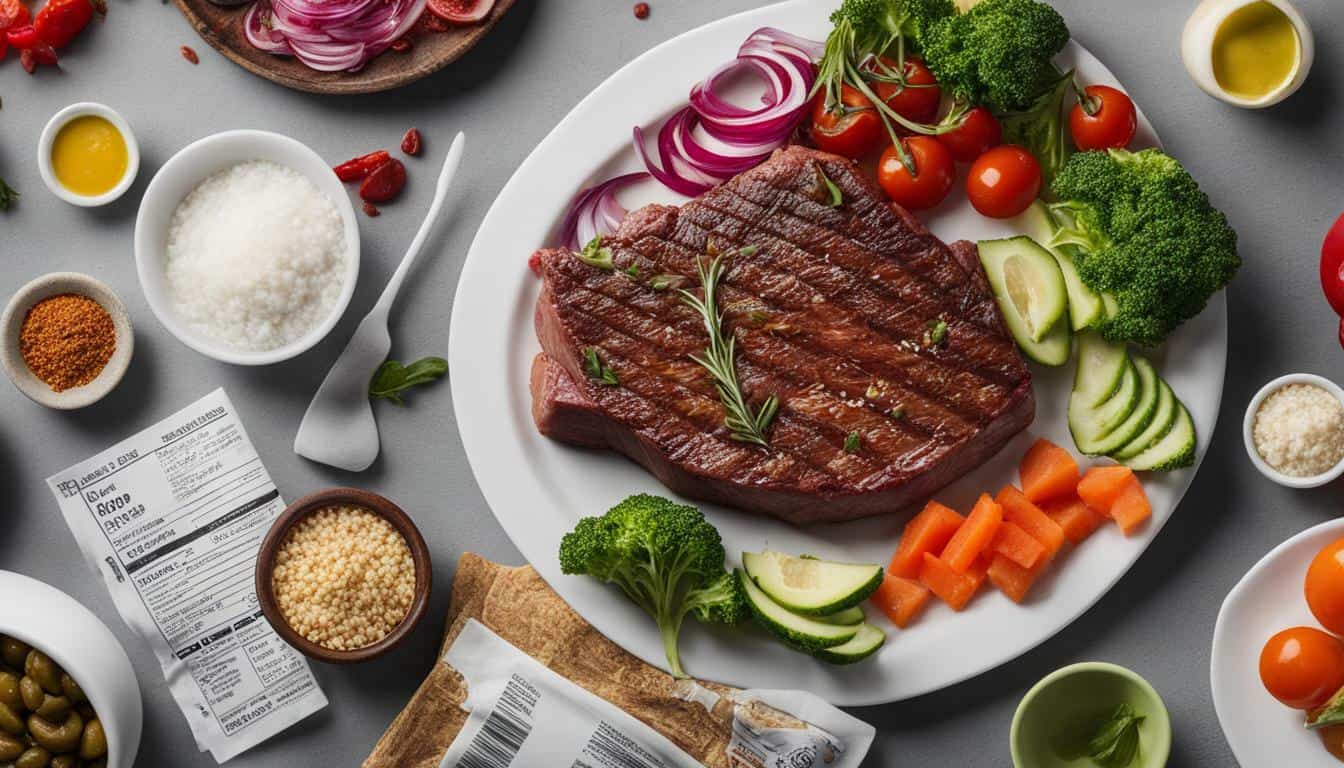
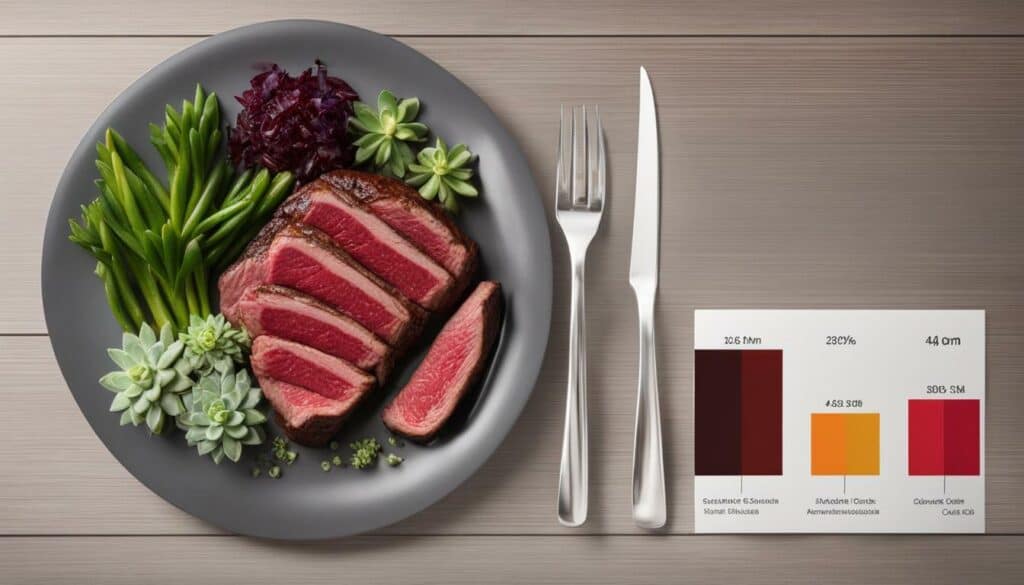



Leave a Reply